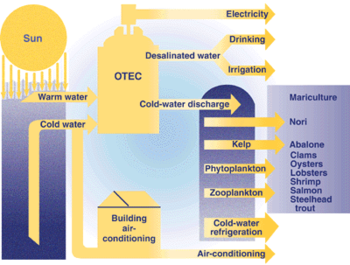Several countries believe that energy can be produced from ocean thermal gradients. They have been evaluating the use of the large thermal differences of tropical oceans for the production of energy. With the thermal heat in the water they want to produce steam that can spin turbines, for the production of electricity. The thermal energy in the oceans would be converted in conversion plants, which would be anchored to the bottom of the ocean. The technology of energy production from heat stored in water has not yet been applied, as it is still in the research phase. Analysts believe that this technology will not have enough economic value to compete with other energy production technologies.
An alternative that may have economic value is the solar pond. By trapping sunlight in a freshwater pond the water will warm up, which causes steam production. This steam is trapped and used to spin turbines for electricity production. The principle is the same as electricity production from thermal energy in oceans, however, the technology is much simpler and it has moderate construction and operating costs.
Ocean thermal energy conversion (OTEC) uses the temperature difference between cooler deep and warmer shallow or surface ocean waters to run a heat engine and produce useful work, usually in the form of electricity. OTEC is a base load electricity generation system, i.e. 24 hrs/day all year long. However, the temperature differential is small and this impacts the economic feasibility of ocean thermal energy for electricity generation.
Systems may be either closed-cycle or open-cycle. Closed-cycle engines use working fluids that are typically thought of as refrigerants such as ammonia or R-134a. These fluids have low boiling points, and are therefore suitable for powering the system’s generator to generate electricity. The most commonly used heat cycle for OTEC to date is the Rankine cycle using a low-pressure turbine. Open-cycle engines use vapour from the seawater itself as the working fluid.
OTEC can also supply quantities of cold water as a by-product. This can be used for air conditioning and refrigeration and the nutrient-rich deep ocean water can feed biological technologies. Another by-product is fresh water distilled from the sea.
OTEC theory was first developed in the 1880s and the first bench size demonstration model was constructed in 1926. Currently the world's only operating OTEC plant is in Japan.
http://en.wikipedia.org/wiki/Ocean_thermal_energy_conversion
http://www.lenntech.com/water-energy-faq.htm#ixzz2vvmWGYg8
http://www.lenntech.com/water-energy-faq.htm
